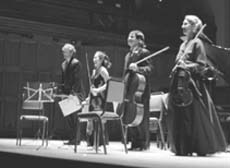

Music Director Paul Polivnick conducted the Oberlin Chamber Orchestra in an enjoyable concert Sunday evening. It was a lively way to begin this year's Chamber Orchestra's concert series, and reminded the audience of the caliber of Oberlin musicianship. The program consisted of Beethoven's Symphony No. 1 in C-Major, Op. 21, Ravel's "Schéhérazade" and Tchaikovsky's "Serenade for Strings," Op. 48.
The Chamber Orchestra opened with the Beethoven, and performed it dramatically. "Symphony No. 1" includes many surprises for the listener. In the opening phrase of the first movement, the tempo is slow and methodic. After a while, however, the tempo moves into a lively allegro, leaving the former theme behind.
Another surprise is the similarity in endings of the first and fourth movements: both
resolve with rich, forte chords. Finally, all four movements have moderate to brisk tempos, and this last
point seemed the most noticeable Sunday night. The orchestra was able to explore these surprises
throughout the piece. The string section's tone was quite clear and lyrical. They played with acute precision
throughout even the most difficult passages. The woodwinds and brass accompanied the rest of the
orchestra by creating crescendos and piercingly resonant chords. The percussion section also played an
accompanying role, most noticeably in the second movement. 
Ravel's "Schéhérazade" concluded the first half of the program. The three-movement piece, for orchestra and voice, featured Lorraine Manz, of the voice faculty. The text, by Tristan Klingsor, describes pleasing sights and sounds that the narrator never fully experiences. Each movement describes different ethereal elements that the narrator longs for. "Asie" recounts people and places in Asia that seem exotic and magical, "La Flûte Enchantée" describes a melody being played on a flute that is light and distant, and "L'Indifférent" tells of a mysterious but attractive stranger.
The music of Ravel's piece is full of rich harmonies, which envelop the listener in ominous tones. Stark contrasts abound in the piece. The orchestra and vocal parts build to a state of frenzy and intense emotion, but then are calmed gradually. Under Polivnick's conduction, the orchestra was able to create these conflicting sweeps quite well, with the creation of large crescendos and the use of subtle quietness. At times, the vocal part had a longing quality to it, which complemented the text's theme. Manz was able to create distant and unsatisfied emotion, leaving a deep impression on the listener. Her voice gave the melody a dream-like quality, making it seem detached and disconnected.
The second half of the program featured only the string section in a beautiful interpretation of Tchaikovsky's "Serenade for Strings." Even though the orchestra was comprised only of strings, the sound was intense, nonetheless. Immediately, the chords overrun with their resonant and deep-felt emotion. They cry out mournfully. Then, as the melody continued, it overwhelmed with its dramatically increased tempo. The rests in the piece gave the listener moments to ponder what Tchaikovsky would do next.
One common element throughout the four movements was the dialogues occurring between different instruments. In the second movement, for example, the first violins create an interaction with the cellos and basses, then with the second violins. This creates a balance between the various parts in the group, with each section responding, creating a unique flow.
The orchestra's repertoire in this program covered a range of musical periods and styles. Their playing was quite passionate and displayed technical skill as well as an enthusiasm for all the pieces on the program. Polivnick led the orchestra intently and with serious determination. Moreover, the entire orchestra proved adeptly responsive in their reactions. All of these factors contributed to a vigorous vitality that brought energy to Finney Chapel and to the audience.
Copyright ©
1999, The Oberlin Review.
Volume 128, Number 6, October
8, 1999
Contact us with your comments and suggestions.